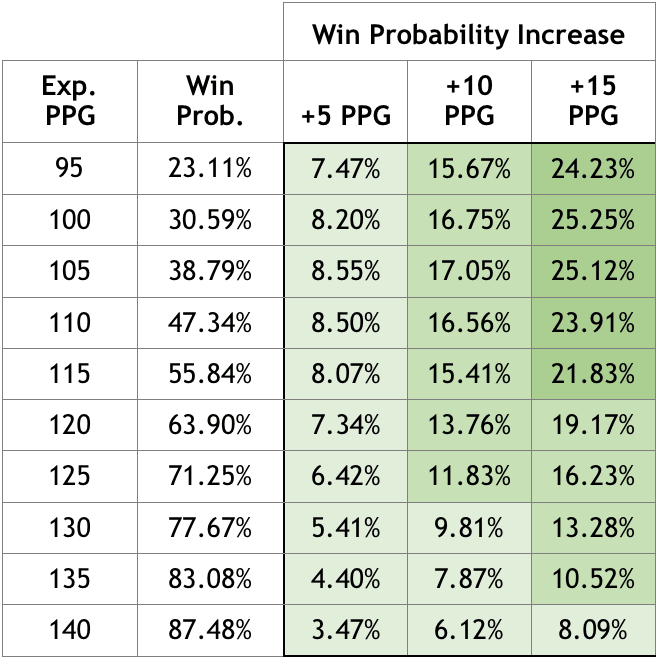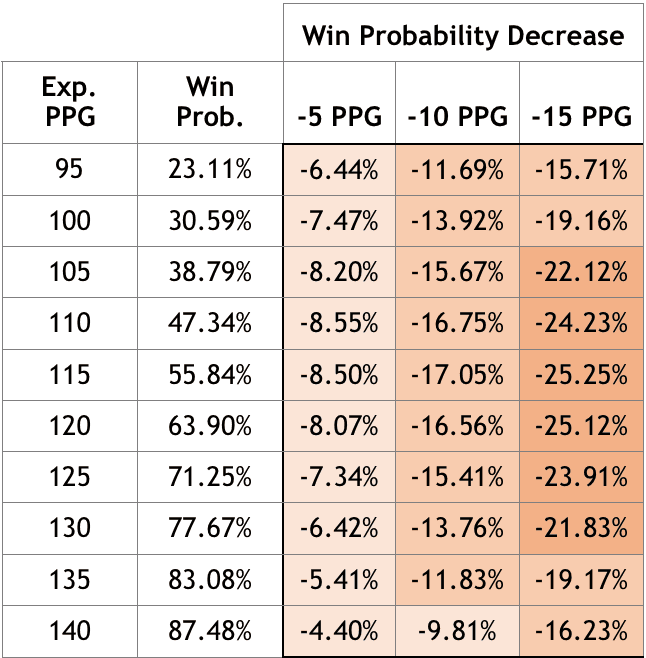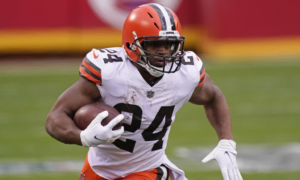The Futility of the Win Now Trade
Editor’s Note: This article is submitted by Member Corner writer, Nick Canzanese (known in the DLF forum as ‘Zounder’). We look forward to seeing much more of Nick’s work in the future.
Most owners believe that “Win Now” trades, or moves that sacrifice overall value in the name of present value, are a great way to control win/loss outcomes in the short term to make a playoff and championship push. Is that really the case? How likely is a trade of that nature to be the difference between a win and a loss in any given matchup? Adam Harstad of Footballguys has written on this topic, and it has inspired me to investigate as well.
Margin of Victory
My dynasty league has five years’ worth of weekly scores and uses a regular lineup and scoring system. (0.5 PPR, QB/RB/RB/WR/WR/WR/TE/FLEX/DEF/K) I feel this league is as good a representation of a normal dynasty league as I could possibly find, with a big sample size of 420 regular-season games (or 840 individual weekly scores). I recorded every individual weekly score and the results of every head-to-head matchup, including margin of victory, so we can see just what we’re up against in trying use Win Now trades to turn what would otherwise be a loss into a win.

This tells us that 50% of head-to-head matchups resulted in a margin of victory of 20.59 points or less. Only three non-quarterbacks hit that point per game threshold (David Johnson, Le’Veon Bell, Ezekiel Elliott.) That means that on average, having an extra top three running back added to a roster wouldn’t have made a difference in 50% of all losses!
Furthermore, we also have to remember that when making a “Win Now” trade, you are not adding a player to your lineup, you are replacing a player in your lineup. The actual expected point increase from a Win Now trade is much less than it appears, unless you weren’t starting anyone in that lineup spot.
Additionally, it’s not likely to add a megastar to your lineup via trade. A ten point per game increase is more likely, and that would turn a loss into a win only 27% of the time. A five point per game increase would turn a loss into a win only 15% of the time.
The reason the average Margin of Victory is so large (and the reason the chances of turning a loss into a win is so small) is because of high variance in week-to-week fantasy scores. Owners should account for this when considering a Win Now trade.
Win Probabilities
Let’s get more specific: How much does adding a specified amount of expected point per game increase win probability? To answer that, I created a distribution of all 820 weekly scoring results. We need to know the shape of the distribution because adding points per game to a lineup will matter more for a middling team than an elite one.
It’s doubtful the sample distribution from my league is representative of the true distribution of weekly point totals, so I used statistical software to find the best fit distribution (generalized logarithmic) and then calculated probabilities based on that distribution instead. This distribution is much more likely to be representative of other leagues. The results are as follows:

For example, a team that is expected to score 110 points per game has a win probability of 47.34% any given week in the regular season. Adding five points per game to the expected score would increase their weekly win probability by 8.50%. It’s important to note that most teams in the sample averaged between 100 and 130 points per game through a whole season, but I included the extremes to give you the full scope. Here’s what I took from this data:
-These numbers are lower than one would like. You will need to play many games for an expected win increase of five percent to 15% to manifest itself. For example, making a move to increase your win probability by ten percent is likely to net you at least one more win throughout the regular season. If you’re making the move with only a few weeks left at the end of the season or at your league’s trade deadline, it’s not likely to ever have an impact. Timing matters when making these kinds of trades. The earlier you pull the trigger, the more chances you get for the trade to have an impact. (There are obvious exceptions. For example, if you’re unable to fill a starting lineup due to injuries and you’re pushing for a playoff spot, it’s probably worth the risk, no matter how many games are left.)
-Consider that making a Win Now trade doesn’t necessarily guarantee that you will net those extra points per game. You may even lose points! So first, you have to hope that the trade actually gives you the points you think it will. Then, you have to hope the trade turns enough losses into wins. Compounding those probabilities gives an even bleaker scenario. Owners are likely not to get what they want out of a Win Now trade, especially those made later in the season.
-There appears to be a sweet spot in terms of getting the most bang for your buck. The hump of this data distribution is close to the mean of 112.7 points per game, so you get the largest increase in win probability per point added by getting over that hump (passing the 112.7 expected point threshold.)
-These win probabilities are only accurate for the regular season, since that’s how the sample was collected. (The sample size for the playoffs was too small.) The average point total is likely much higher in the playoffs, so that will change the position of the “hump” in the data distribution. Thus, teams with higher expected point totals are getting more bang for their buck than the chart indicates. It’s worth noting, though, there aren’t that many opportunities for the move to pay off during the playoffs, since there are only two or three games.
-This chart would look different if this were a PPR league, if there were more/less owners, more/less starting spots, etc. But I think it would lead to the same general takeaway. Regardless of what league you play in, this is actionable information.
We can also look at this from a reverse perspective: How much does losing a specified amount of expected points per game decrease win probability?

For example, a team that is expected to score 115 points per game has a win probability of 55.84% any given week in the regular season. Subtracting five points per game from the expected score would decrease their weekly win probability by 8.5%.
Teams scoring 125+ points or more can afford to reduce their weekly expected points and it’s not likely to impact any outcomes, especially if done late in the season. Now, I wouldn’t take this idea to the extreme and sell your half of starting lineup for rookie picks after you clinch a playoff spot. But most contending owners automatically hold expiring assets because they feel they have to. I think this data shows that you can sometimes afford to make your team better in the long term without risking short term outcomes.
I did this twice last season. After week one, I traded for a recently-injured Keenan Allen and gave up a still-healthy RB1 Doug Martin to a contending owner. My next best running backs were Ryan Mathews and Duke Johnson. Other owners were stunned that I would make such a move despite my team being a preseason favorite, having won the championship the year prior. Remember when I mentioned that Win Now trades aren’t even necessarily guaranteed to net you more points in the short term? Martin got hurt, that owner missed the playoffs and my team’s outcomes for the rest of the season were not impacted at all.
Then in midseason, with my team struggling in the middle of the standings and needing a big late season push, instead of making a Win Now trade, I did the opposite and traded Brandon Marshall for two second rounders to another contender. That owner also traded a first rounder and Kevin White for DeMarco Murray. My team was left for dead and that owner’s team become a playoff lock. Yet, I finished second while the other owner finished fourth, out of payout range.
Conclusion
Fantasy football is random. By making Win Now trades, many owners dream that the control they have over weekly outcomes is far greater than it really is. Exploit this belief by letting the other teams in your league make the Win Now moves, especially if it’s late in the season. And don’t afraid to be the one on the other end, reaping long term value at the expense of the misplaced confidence of your competitors, even if you’re a playoff contender. Do what’s best for your team in the long run and let the wins follow.
- 2018 Summer Sleeper: New York Jets - July 29, 2018
- 2018 Summer Sleeper: Pittsburgh Steelers - July 24, 2018
- 2018 Rookie Profile: Michael Gallup, WR Colorado State - April 21, 2018


































































